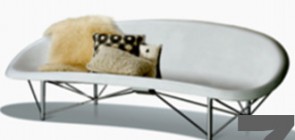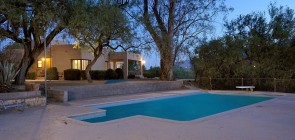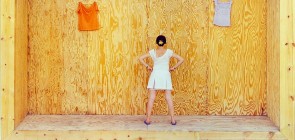When the Tucson Botanical Gardens held a three-day landscaping competition recently, the heat was on for four designers to make a small space beautiful - and quickly. Here, People's Choice winner Scott Calhoun dishes the dirt on his Growdown! experience.
I'd always avoided entering garden design competitions. It seemed to me that gardens made on a short timeline were usually flimsy, trendy, and exuded a made-for-reality-TV-quality as strong as a whiff of Ty Pennington’s cologne.
Still, I had to admit that some of the display gardens built for competitions were creative and interesting: the San Francisco Flower Show, Seattle's Northwest Flower and Garden Show, and the Philadelphia Garden Show all feature ambitious horticulture and garden design elements. At the San Francisco show I once watched a designer recreate a Baja, Mexico beach-themed garden complete with blooming native wildflowers and palms, and a surfboard-laden VW van. It was novel, and maybe a bit trendy, but it was done to excellent effect.
In the desert Southwest, the serious garden show scene has been non-existent. We've had home-show-style events featuring booths with spas, barbeque grills, and masonry products, with vendors selling chamois cloth and non-stick cookware. But for anyone interested in arid land horticulture, native plants, or desert-appropriate landscape structures, there hasn’t been much to see.
So when I heard that Tucson Botanical Gardens was sponsoring a garden design competition called Growdown! - designers going trowel to trowel to come up with the best small garden space in Tucson - I jumped at the chance. Why?
- The gardens would be built outdoors in a vacant corner of TBG.
- They were the sort of small dimensions that I loved to work with: 15’ x 20’.
- The display gardens we would design and build would stay in place for over two months.
- We could do whatever we wanted to.
- Nobody would be hawking non-stick cookware in the vicinity.
Other aspects of the competition weren’t so enticing. The garden had to be completely constructed over three days (with a strict eight hours per day). The designers selected would only receive a modest $1500 stipend for the entire project. And, sometime in May, we’d have to tear everything out.
January 4th: Growdown! Application Due
My application was based on a color theme, and featured photos of a Nogales, Sonora city bus, a storefront Viagra advertisement, and a fan deck of Mexican license plates. As divergent as they were, all of my photo examples emphasized the use of color in the garden in a style based on cross-border panache.
January 18th: Let the Obsession Begin
 At 7:58 in the evening, I got the email saying that our design had been chosen. From that moment on, I was all in. When I’m in the thick of designing a garden, it’s all I can think about. As my Growdown! garden began to take shape on paper, the lines of its curvilinear pathway, the teal and orange colors of its walls all circulated in my head day and night like a lover’s whispers. Unable to sleep for many nights in a row, I woke at 3:00am to draw sketches and make plant lists.
At 7:58 in the evening, I got the email saying that our design had been chosen. From that moment on, I was all in. When I’m in the thick of designing a garden, it’s all I can think about. As my Growdown! garden began to take shape on paper, the lines of its curvilinear pathway, the teal and orange colors of its walls all circulated in my head day and night like a lover’s whispers. Unable to sleep for many nights in a row, I woke at 3:00am to draw sketches and make plant lists.
January 29th: Heavy Metal & Buddy the Dog
 To give the Growdown! garden a real sense of enclosure, it needed a steel perimeter to serve as walls, and a 205-pound steel chiminea/grill. My go-to steel man, Chris Drake of Drake Built Projects, would have to make all of these components ahead of time in his shop. Chris is built like a linebacker and operates his business out of a garage and yard with a partially assembled VW Baja Bug, a race-ready Honda desert motorcycle, and a giant mastiff mix named Buddy. We wanted the steel pieces to have a nice orange rust color, so Chris sprayed them with an acid to speed the process. Buddy helped by urinating on every piece of steel within pissing distance which, curiously, worked faster than the acid.
To give the Growdown! garden a real sense of enclosure, it needed a steel perimeter to serve as walls, and a 205-pound steel chiminea/grill. My go-to steel man, Chris Drake of Drake Built Projects, would have to make all of these components ahead of time in his shop. Chris is built like a linebacker and operates his business out of a garage and yard with a partially assembled VW Baja Bug, a race-ready Honda desert motorcycle, and a giant mastiff mix named Buddy. We wanted the steel pieces to have a nice orange rust color, so Chris sprayed them with an acid to speed the process. Buddy helped by urinating on every piece of steel within pissing distance which, curiously, worked faster than the acid.
January 28th: Meeting the other Growdown! Designers
At an afternoon meeting, I met the other designers: Christine Jeffreys, an extreme athlete (she competes in Xterra races) who attended ASU on a full swimming scholarship while getting a master’s degree in landscape architecture; Phil and Janice Van Wyck, a husband and wife duo with many years of design experience and a book of work that included projects in Tucson Botanical Gardens; and Ezra Roati, of REALM, one of the most visible residential landscape contracting firms in Tucson with a fleet of branded trucks and equipment. It looked like stiff competition.
January 31st: Thrown, Fired & Glazed
 The steel work I’d designed had so many pot shelves that I needed pots. I had originally thought I might be able to get away with some cheap teal plastic pots from Target, but as the design evolved, I knew that what the space really called for was something custom, handcrafted, and unique. Local clay artist Debra Raeber came to my rescue. She taped up all of the drawings of our design to the wall of her studio, and hand threw, fired, and glazed 39 teal and orange pots designed specifically to match the style and color of our garden.
The steel work I’d designed had so many pot shelves that I needed pots. I had originally thought I might be able to get away with some cheap teal plastic pots from Target, but as the design evolved, I knew that what the space really called for was something custom, handcrafted, and unique. Local clay artist Debra Raeber came to my rescue. She taped up all of the drawings of our design to the wall of her studio, and hand threw, fired, and glazed 39 teal and orange pots designed specifically to match the style and color of our garden.
February 6th: Fifty Shades of Silver
 Because I love plants and believe that they matter a lot in garden design, my designs tend to be plant-driven. The size of the space, the exposure, the color theme - all of these determine which plants make the cut. Since the hardscape elements of my garden were walls of orange and teal, I made a decision early on to select only plants with silver and gray foliage. Fifty shades of silver wasn’t a new geriatric version of the popular erotic novel, it was my mantra for choosing my plant palette.
Because I love plants and believe that they matter a lot in garden design, my designs tend to be plant-driven. The size of the space, the exposure, the color theme - all of these determine which plants make the cut. Since the hardscape elements of my garden were walls of orange and teal, I made a decision early on to select only plants with silver and gray foliage. Fifty shades of silver wasn’t a new geriatric version of the popular erotic novel, it was my mantra for choosing my plant palette.
 The centerpiece was big beaked yucca (Yucca rostrata), native to the Chihuahuan desert and tall, handsome with silver-blue leaves and a mop head. It was donated by Mountain States Wholesale Nursery.
The centerpiece was big beaked yucca (Yucca rostrata), native to the Chihuahuan desert and tall, handsome with silver-blue leaves and a mop head. It was donated by Mountain States Wholesale Nursery.
At Civano Nursery, I found a group of dwarf silver slippers, and at Desert Survivors Jim Verrier pointed me toward Sonoran Everlasting, a handsome silver weed with leaves that smell like lemons. Mark Sitter at B & B Cactus Farm contributed some blue pearl bush and Greg Starr chipped in three handsome silver mescal ceniza agaves (Agave colorata). Marc White, of Casa Blanca, contributed silver hedgehogs, and trio of white-flecked Astrophytum. At Mesquite Valley growers, I found some trailing silver fishhook (a succulent) and other plants to fill a steel flower box. The result? A silver collection that shimmered in the sun.
Early in the morning, Chris Drake arrived with a truckload of beautiful rusted steel panels. The largest two panels were exceeding heavy, and I remarked that they “had hernia written all over them,” but we moved them without incident. The videographer hired to shoot the event showed up and got some footage of Chris and I joking about avoiding plumber’s crack in the video. Chris was threatening to wear an orange thong. My team's 'uniform' was t-shirts I had printed with “Equipo Growdown!” on the back. The morning of load-in, we had our steel, gravel, and plants ready to go.
March 21st, Day One: Generators, Jackhammers & Africanized Bees
Our landscape contractor, Marc White of Casa Blanca, got held up and Chris Drake and I were on the job without an essential Tucson gardening tool: the Mikata electric jackhammer. We began digging postholes with 17 pound steel digging bars, also known as death sticks because of how you feel after using them. Midmorning, someone poked their head over the wall and warned us of a swarm of bees on the other side. We reported this to garden staff, and kept working. At the end of the day, our back wall was orange, we had mixed and poured 1600 pounds of concrete, placed our circular steel planter complete with beaked yucca, and placed five of our steel partition walls. Our steel edging was also installed. I explained to Jesus that the curve and constriction of the pathway should resemble the contour of a woman’s hip and the small of her back, a concept he seemed to execute intuitively. As a bonus that first day, we experienced zero bee attacks and zero plumber’s crack complaints.
March 22nd, Day Two: Planting, Irrigation, and Sonoran Hot Dogs
 Early on, we made a decision to not take any shortcuts in our Growdown! space. We would build this garden exactly how we would build a client’s garden. We had a real two-zone drip irrigation system, complete with copper backflow assembly and a timer.
Early on, we made a decision to not take any shortcuts in our Growdown! space. We would build this garden exactly how we would build a client’s garden. We had a real two-zone drip irrigation system, complete with copper backflow assembly and a timer.
As Chris Drake finished welding on pot shelves, we began planting. By midday, my wife Deirdre and I had our “roof”--a panel of reed-mat shade suspended overhead by steel cables—installed, and it cast a dappled shade. Deirdre brought Mexican hot dogs for lunch, which we consumed with gusto.
March 23rd, Day Three: Pots, Erotic Drilling, and Mexican Plates
 The final day was mostly finishing touches. Up went nine expired Sonora Mexico license plates to our steel wall panels, and 39 pots from Debra Raeber on shelves and on the walls. The pots, planted with silver plants weeks before, gave the garden a feeling of instant maturity.
The final day was mostly finishing touches. Up went nine expired Sonora Mexico license plates to our steel wall panels, and 39 pots from Debra Raeber on shelves and on the walls. The pots, planted with silver plants weeks before, gave the garden a feeling of instant maturity.
There were a few last construction tasks. Chris Drake was working with a drill to attach a waist level planter box to the back wall. Never one to avoid innuendo, Chris announced, “those of you with pacemakers look away now” as he proceeded to bore anchor holes by thrusting his hips toward the wall in time with the revving of his drill. Deirdre and Amy arrived with a truck of furnishings, including two Mexican concha chairs to complete the look. By one in the afternoon, it all looked complete. It felt like a garden. We sat down in the chairs and we didn’t get up until sundown.
March 24th: The Judging
On our right, Ezra Roati built a garden with an urban rainwater feature and veggie beds; on our left, Christine Jeffreys erected a garden beneath a big shade sail; across the way, Phil and Janice Van Wyck built what looked to me like a desert Japanese tea house (below) complete with a butterfly roof. Phil and Janice received the Judges Award, and we came away with the People’s Choice.
In the end, I was proud of our teamwork, and a little in love with the garden we created. In the 20-odd days since the competition ended, I’ve found that I can’t drive by Tucson Botanical Gardens without stopping to sit, to deadhead, and to take photos. I’ve begun taking tilt-shift, or miniature effect photos, of the garden, because in some ways, that is what the garden is. In those images, the garden appears like a railroad diorama of everything I love about gardens. Other than writing a book, I’ve never had a single creative pursuit so completely take over my life. For several reasons, I’m not looking forward to removing this little garden that is bent on color, forged of steel, and bristling with desert plants.
* Scott Calhoun, owner of Zona Gardens in Tucson, is the author and photographer of six books on the American Southwest. He has had his work featured in The New York Times and The Wall Street Journal, and writes a monthly column for Sunset magazine. Find out more at www.zonagardens.com.













![IMG_1937[1]](https://3storymagazine.com/wp-content/uploads/2013/06/IMG_19371-295x140.jpg)

![IMG_1966[1]](https://3storymagazine.com/wp-content/uploads/2013/06/IMG_19661-295x140.jpg)



" I’ve never had a single creative pursuit so completely take over my life. For several reasons, I’m not looking forward to removing this little garden that is bent on color, forged of steel, and bristling with desert plants."
Oh, can't they stay...just a little bit longer. Loved this blow by blow account of the creation of this garden.
Loved that you alerted us to it in the first place! Thanks for reading.